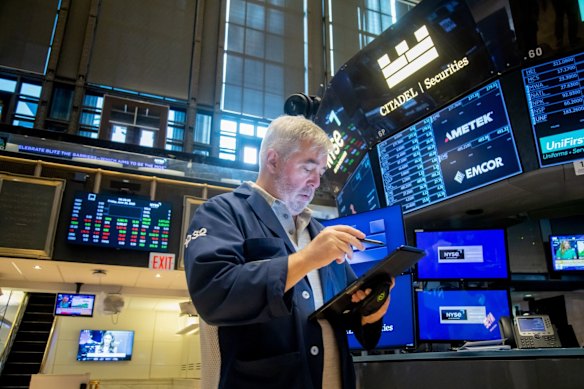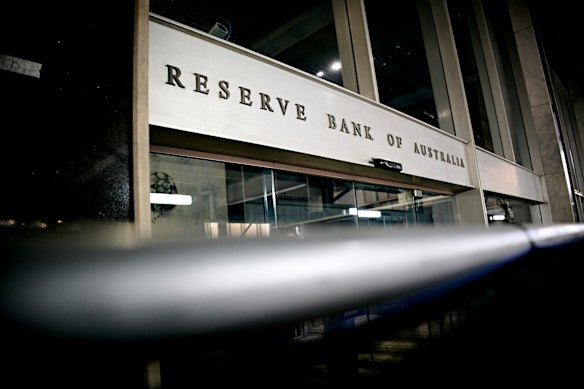- Updated
- Business
- Markets
- World markets
ASX edges ahead on energy boost; Michael Hill founder dies
By Staff reporter
Welcome to your five-minute recap of the trading day.
The numbers
After starting the session down as many 54 points and staying in the red for most of the day, the benchmark S&P/ASX 200 index moved into positive territory in the last 40 minutes of trading to finish Tuesday up 6.9 points, or 0.1 per cent, to 8704.6. Six of the 11 sectors ended higher.

Wall Street has made a solid start to the week.Credit: Bloomberg
The broader All Ordinaries gained 3.2 points, or 0.04 per cent, to 8966.7.
The Australian dollar slipped further against its strengthening American counterpart, buying US65.26¢, from US65.5¢ at 5pm on Friday.
The lifters
Energy was the best performing sector, gaining 0.6 per cent and 1.1 per cent for the past five days, boosted by rising oil prices. Woodside rose 1.6 per cent as it announced it is taking 100 per cent operatorship of the Bass Strait Gippsland Basin operations from ExxonMobil subsidiary Esso Australia. Santos added 2.1 per cent.
Financials managed to end the session 0.1 per cent ahead, with two of the big four banks stronger. NAB gained 1.2 per cent and ANZ Bank was up 0.03 per cent.
The laggards
The heavyweight mining sector dipped 0.1 per cent. Fortescue fell 0.3 per cent and Rio Tinto was 0.02 per cent lower, while BHP ended the session 0.3 per cent higher.
Viva Energy was the biggest loser on Tuesday, falling 6.4 per cent after the OTR and Reddy Express petrol station owner said a big drop in tobacco sales had led to a 10 per cent decline in overall convenience sales in the first half.
Uranium producers were down for a second day, with Paladin dropping 5.8 per cent and Boss Energy falling another 5.5 per cent, on top of Monday’s 44 per cent plunge following word of issues at its Honeymoon mine in SA.
Shares in jeweller Michael Hill lost 12.5 per cent after the company announced the death of its founder, Sir Michael Hill, on Tuesday morning.
Among the financials, Westpac fell 0.1 per cent, Commonwealth Bank lost 0.4 per cent and Macquarie was down 0.4 per cent.
The lowdown
The local sharemarket has clawed back its losses to close marginally higher ahead of a key inflation readout that could determine whether the Reserve Bank cuts interest rates next month.
Traders may have been taking something off the table ahead of the Australian Bureau of Statistics’ release of second-quarter consumer price index data on Wednesday morning.

The Reserve Bank has been under fire for waiting too long to start cutting interest rates.Credit: AFR
HSBC chief ANZ economist Paul Bloxham said the bank expected the readout would show the Reserve Bank’s preferred inflation metric to print at 0.6 per cent quarter-on-quarter and 2.7 per cent year-on-year, which HSBC sees as allowing the central bank to trim rates in August.
But if trimmed mean inflation came in at higher than that, an August rate cut would be less likely, Bloxham said.
In the US, the Federal Reserve’s rate-setting committee is widely expected to leave rates on hold when it announces its latest decision early on Thursday Australian time, but its commentary will be closely scrutinised for a clue whether a rate cut might be possible in September.
Overnight, US stock indexes drifted through a quiet session after the United States agreed to tax cars and other products coming from the European Union at a 15 per cent rate, lower than President Donald Trump had earlier threatened. Many details of the trade deal are still to be worked out, and Wall Street is heading into a week full of potential flashpoints that could shake markets.
The S&P 500 was nearly flat and edged up by less than 0.1 per cent to set an all-time high for a sixth straight day. The Dow Jones dipped 64 points, or 0.1 per cent, while the Nasdaq composite added 0.3 per cent to its own record.
Tesla rose 3 per cent after its CEO, Elon Musk, said it signed a deal with Samsung Electronics that could be worth more than $US16.5 billion ($25.3 billion) to provide chips for the electric-vehicle company. Samsung’s stock in South Korea jumped 6.8 per cent.

Tesla rose 3 per cent after CEO Elon Musk said it signed a deal with Samsung Electronics.Credit: AP
Other companies in the chip and artificial-intelligence industries were strong, continuing their run from last week after Alphabet said it was increasing its spending on AI chips and other investments to $US85 billion this year. Chip company Advanced Micro Devices rose 4.3 per cent, and server-maker Super Micro Computer climbed 10.2 per cent.
But an 8.3 per cent drop for Revvity helped to keep the market in check. The company in the life sciences and diagnostics businesses reported a stronger profit for the latest quarter than Wall Street expected, but its forecast for full year profit disappointed analysts.
Companies are broadly under pressure to deliver solid growth in profits following big jumps in their stock prices the last few months. Much of the gain was due to hopes that Trump would walk back some of his stiff proposed tariffs, and critics say the US stock market looks expensive unless companies produce bigger profits.
More fireworks may be ahead this week. “This is about as busy as a week can get in the markets,” according to Chris Larkin, managing director, trading and investing, at E-Trade from Morgan Stanley.
Hundreds of US companies are lined up to report how much profit they made during the spring, with nearly a third of the businesses in the S&P 500 index scheduled to deliver updates. That includes market heavyweights Apple, Amazon, Meta Platforms and Microsoft. Those companies have grown so huge that their stock movements can almost dictate what the overall S&P 500 index does. Microsoft alone is worth $US3.8 trillion.
On Wednesday, the Federal Reserve will announce its latest decision on interest rates.
Trump has been angrily calling for the Fed to cut interest rates, a move that could give the economy a boost. But Fed chair Jerome Powell insists that he wants more data about how Trump’s tariffs are affecting the economy and inflation before the Fed makes its next move. Lower interest rates can fuel inflation, and the economy only recently came out of its scarring run where inflation briefly topped 9 per cent.
The widespread expectation on Wall Street is that Fed officials will wait until September to resume cutting interest rates, though a couple of Trump’s appointees could dissent in the vote. The Fed has been on hold with interest rates this year since cutting them several times at the end of 2024.
This week will also feature several potentially market-moving updates about the economy. On Tuesday will come reports on how confident US consumers are feeling and how many jobs openings US employers were advertising. Wednesday will show the first estimate of how quickly the US economy grew during the spring, and economists expect to see a slowdown from the first three months of the year.
On Thursday, the latest measure of inflation that the Federal Reserve prefers to use will arrive. A modest reading could give the Fed more leeway to cut interest rates in the short term, while a hotter-than-expected figure could make it more cautious.
And Friday will bring an update on how many more workers US employers hired during June than they fired.
In sharemarkets abroad, indexes dipped in Europe following the announcement of the trade deal’s framework.
With AAP, AP
The Market Recap newsletter is a wrap of the day’s trading. Get it each weekday afternoon.